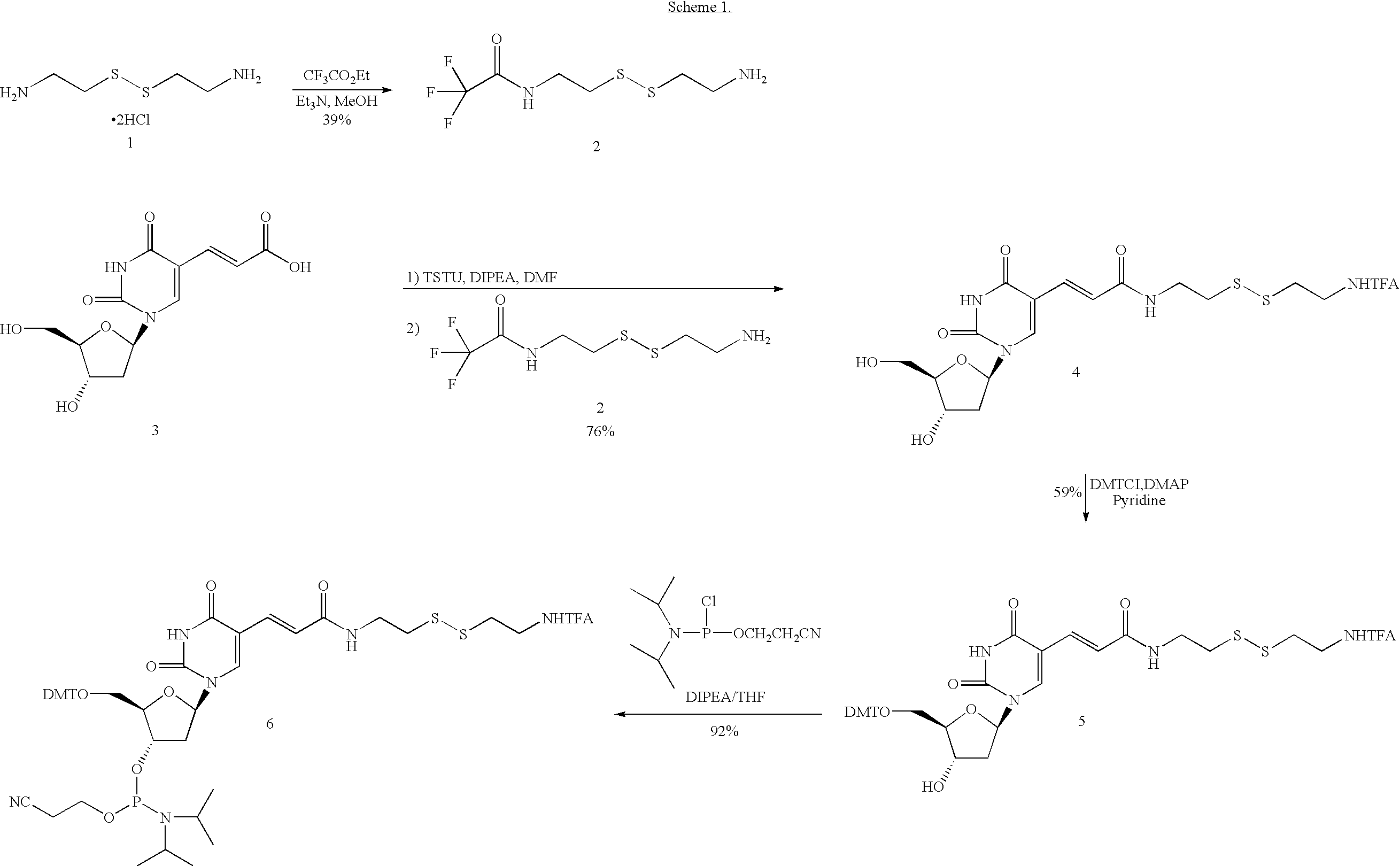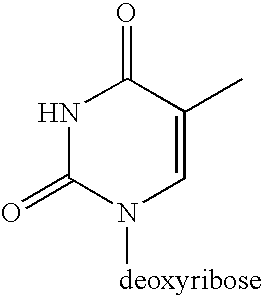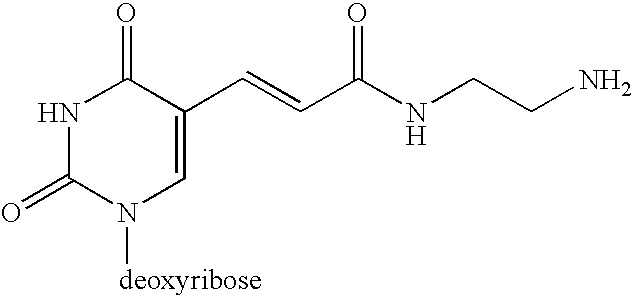Immobilized probes
a probe and immobilized technology, applied in the field of nucleic acid analysis, can solve problems such as unscheduled amplification
- Summary
- Abstract
- Description
- Claims
- Application Information
AI Technical Summary
Benefits of technology
Problems solved by technology
Method used
Image
Examples
example 1
Synthesis of Thiol Linker dT Phosphoramidite
[0059] The design of the linkers that tether both the capture primer and the pre-circle probe to the support is an important aspect of the invention. The cleavable linker must bind effectively and specifically to the support matrix and should be efficiently cleaved under mild chemical conditions that will not damage DNA. One possible synthetic route is depicted in Scheme 1.
General
[0060] All commercially available chemical reagents were used without further purification. Analytical TLC was performed on 0.2 mm silica 60 coated aluminium foils with F254 indicator (Merck). Flash column chromatography was performed using flash chromatography silica gel (BDH). NMR spectra were recorded on a Jeol Lambda 300 MHz spectrometer operating at 300 and 75 MHz for 1H and 13C, respectively and 121 MHz for 31P. Electrospray ionization mass spectra were recorded on a Finnigan Navigator LC-MS mass spectrometer.
4. N-[2-(2-Amino-ethyldisulfanyl)]-2,2,2-tri...
example 2
Synthesis of Linker-Modified Pre-Circle Probes
[0076] Four 94 nucleotide pre-circle probes of identical DNA sequence (SEQ Id No 2) were made using O-cyanoethyl phosphoramidite chemistry on an Applied Biosystems 374 automated DNA synthesiser. All were 5′ phosphorylated. In SEQ2a the dT base at position 58 carried a C6 amino spacer (Glen Research, Amino-Modifier C6 dT, #10-1039-90). In SEQ2b the same nucleotide was biotin dT (Glen Research, Biotin-dT, #10-1038-95). In SEQ2c, dT number 58 had a C2 amino spacer arm (Glen Research, Amino-Modifier C2 dT, #10-1037-90). SEQ2d contained thiol linker dT (Compound 6, in Example 1, Scheme 1) at nucleotide 58. All probes were purified by reverse phase HPLC and stored at −20° C. in nuclease-free, phosphatase-free water (Fluka, #95284). When circularized, bases 1-25 and 80-94 of the probes are complementary to a portion of the Human cytotoxic T-lymphocyte-associated protein 4 gene (CTLA4) located on chromosome 2. The remaining non-complementary ba...
example 3
Preparation of Pre-Formed Circles
[0077] Pre-formed circle probes were made by enzymatic ligation in the presence of a complementary oligonucleotide guide sequence (SEQ Id No 3). The guide oligo anneals to the 5′ and 3′ terminal regions of the pre-circle probe bringing them together and enabling DNA ligase to repair the single strand nick in the resultant duplex.
[0078] Ligation reactions (100 μl) containing 66 mM Tris-HCl pH7.6, 6.6 mM MgCl2, 10 mM DTT, 6 mM KCl, 66 μM ATP, 1 μM pre-circle probe, 1 μM guide oligo and 30 units T4 DNA Ligase (usb, #70005×) were incubated at 37° C. for 90 minutes.
[0079] Non-ligated probe and residual guide sequences were removed by subsequent addition of 50 units 17 Gene 6 Exonuclease (usb, #70025) and 10 units E. coli Exonuclease I (usb, #70073) and a further incubation for 90 minutes at 37° C.
[0080] Single-stranded circular probe molecules were then purified by phenol / chloroform extraction and ethanol precipitation. Probes were dissolved in 50 μl ...
PUM
| Property | Measurement | Unit |
|---|---|---|
| pH | aaaaa | aaaaa |
| pH | aaaaa | aaaaa |
| pH | aaaaa | aaaaa |
Abstract
Description
Claims
Application Information
 Login to View More
Login to View More - R&D
- Intellectual Property
- Life Sciences
- Materials
- Tech Scout
- Unparalleled Data Quality
- Higher Quality Content
- 60% Fewer Hallucinations
Browse by: Latest US Patents, China's latest patents, Technical Efficacy Thesaurus, Application Domain, Technology Topic, Popular Technical Reports.
© 2025 PatSnap. All rights reserved.Legal|Privacy policy|Modern Slavery Act Transparency Statement|Sitemap|About US| Contact US: help@patsnap.com



